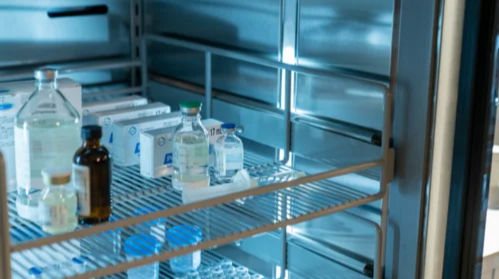Contributor: Cindy Fitton, Director of Marketing, Healthcare and Life Science, Follett
Controlling humidity in medical grade refrigerators is a vital aspect of maintaining the quality and safety of stored products, such as vaccines, blood products, and biological samples. High humidity levels can lead to condensation, frost formation, microbial growth, and corrosion, which can damage the refrigerators and their contents. Therefore, it is essential to monitor and regulate the humidity levels inside the refrigerators using suitable sensors, controllers, and dehumidifiers. This article will discuss some of the methods and challenges for controlling humidity in medical grade refrigerators, as well as some of the best practices and recommendations for optimal humidity management.
Condensation is the process where water vapor in the air is changed into liquid water. It is the reverse action of evaporation, where liquid water becomes a vapor, and is brought about by a change in the pressure and temperature of the substance. You probably see condensation every day. If you wear glasses and go from a cold, air-conditioned room to outside on a humid day, the lenses fog up as small water droplets coat the surface via condensation. People buy coasters to keep condensed water from dripping off their chilled drink glass onto their coffee tables. Cold air holds less water vapor than warm air, and water leaving the vapor state and condensing into liquid as it cools is a naturally occurring part of the refrigeration process.
“Condensate” is the technical term for the liquid that forms when the temperature of the air becomes colder than the saturation temperature (the dew point) of the air-humidity mixture. Managing condensate is important to maintaining the integrity of refrigerated products. The following are some considerations for condensate management in the different types of refrigerators used in the storage of medications, vaccines, and other medical products.
• Condensation Forms in All Refrigerators
In a refrigerator, condensation is the conversion of water vapor in the air to liquid water drops and occurs when humid air in the ambient environment contacts the colder surfaces inside a refrigerator. This is the same effect as dew forming on the grass or on a car’s windshield on a cold morning. According to the laws of physics, all refrigerators will form condensate inside the storage compartment under the humidity levels found in a typical hospital (40% to 50% relative humidity) because the temperature inside the cabinet is lower than the saturation temperature (dew point) of the surrounding air. Condensation will be greater in humid areas and less in very dry climates or during winter months.
• Why Condensation Removal is Important
The management of condensation inside a refrigerator is important for several reasons. First, molds and other biofilms can grow in wet environments. Small microscopic water droplets forming on the walls or shelving inside a refrigerator can be an ideal site for the growth of molds, yeasts, and bacteria that are in the ambient air. The drier the environment, the less likely this is to occur.
In addition, packaging inside the units can be moist and soggy if the condensate is not adequately removed from the storage cabinet.
• Condensation Management Approaches
Different technologies have different approaches to managing condensation. To manage the condensate that will inevitably form inside a refrigerator storage compartment, it is best to accumulate it and let it drain outside the refrigerator where it can evaporate into the air as opposed to having it form inside the refrigerated compartment and potentially compromise any stored products.
The technology that is best for minimizing condensation inside a refrigerator is one with forced air circulation inside the refrigerator. Forced-air refrigeration, coupled with a fin and tube type evaporator, provides the maximum protection against condensation inside the cabinet because the fan forces air through the evaporator, where it condenses on the evaporator coils and fins and drains outside the cabinet where it can evaporate. The additional surface area provided by fin and tube evaporators provides increased cooling capacity and condenses excess water vapor quicker than comparable cold plate or cold wall type evaporators. Depending on how cold the evaporator is operating, a defrost routine can then also be added to clear the evaporator of any frost or ice.
Refrigerators with a cold plate, cold wall evaporator, or thermoelectric-cooled wall technology will be less effective at removing the condensate from the cabinet because there is no forced air circulation pattern. This introduces the risk of the condensate undesirably accumulating on any internal cold surfaces and inviting the growth of unwanted contaminants inside the storage cabinet.
Some manufacturers recommend the use of passive dehumidification using desiccants, such as silica gel or calcium chloride, to absorb moisture from the air inside the refrigerator. The desiccants need to be replaced or regenerated periodically to maintain their effectiveness. Passive dehumidification is a simple and low-cost method, but it may not be sufficient for very high humidity levels or large refrigerators. Additionally, the desiccants may also become a source of contamination.
Others recommend wiping down the inside of the cabinets every day to prevent the adverse effects of condensation. This is a labor-intensive, time-consuming process that does not assure complete dehumidification.

• Possible Mitigations for Managing & Reducing Condensation
• Select a refrigerator that has a low humidity range and a high cooling capacity. Selecting the right equipment for your application is the first step to managing potential humidity issues.
• Place the refrigerator in a well-ventilated area that has a stable temperature and low humidity. A good operating environment will promote stable operation.
• Avoid frequent opening and closing of the refrigerator door, which can introduce moisture and warm air into the refrigerator. Keeping warm, humid air out of the refrigerator by efficient use of door openings will reduce the demand on any humidity control approach.
• Use sealed containers or bags to store products that are sensitive to humidity or moisture. Extra care of moisture sensitive products will provide an additional measure of protection.
• Ensure the door has been closed tightly. Most purpose-built or medical-grade refrigerators include a door-open alert/alarm to notify the user that the door is ajar.
• Check the seal or gasket to be sure it is sealing properly. There are two simple tests you can employ to verify that your gasket is performing properly. The first is to inspect the gasket for any blackening caused by mold. The second involves closing the refrigerator door on a sheet of paper between the gasket and the refrigerator. If you can pull the paper out with no resistance, the gasket isn’t creating a good seal.
• Make sure the refrigerator has adequate room to breathe by following the air clearances provided in your manual.
• Be sure your refrigerator is level, so condensate flows to the drain pan as it should.
Summary
In summary, it is important to note that all refrigerators will generate condensation. The key is to select the right equipment and implement the appropriate maintenance practices for your specific application to assure the safety of medicines, vaccines, and other valuable medical products that are stored inside.






